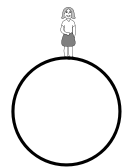| << Chapter < Page | Chapter >> Page > |
Veritasium video on falling objects - 1
Weight is the gravitational force that the Earth exerts on any object. The weight of an objects gives you an indication of how strongly the Earth attracts that body towards its centre. Weight is calculated as follows:
where = mass of the object (in kg)
and = the acceleration due to gravity ( s )
For example, what is Sarah's weight if her mass is . Sarah's weight is calculated according to:

Now, we have said that the value of is approximately on the surface of the Earth. The actual value varies slightly over the surface of the Earth. Each planet in our Solar System has its own value for . These values are listed as multiples of on Earth in [link]
| Planet | Gravitational Acceleration (multiples of on Earth) |
| Mercury | 0,376 |
| Venus | 0,903 |
| Earth | 1 |
| Mars | 0,38 |
| Jupiter | 2,34 |
| Saturn | 1,16 |
| Uranus | 1,15 |
| Neptune | 1,19 |
| Pluto | 0,066 |
Sarah's mass on Earth is . What is her mass and weight on Mars?
m (on Earth) =
m (on Mars) = ?
Weight (on Mars) = ?
Sarah's mass does not change because she is still made up of the same amount of matter. Her mass on Mars is therefore .
Mass is measured in kilograms (kg) and is the amount of matter in an object. An object's mass does not change unless matter is added or removed from the object.
The differences between mass and weight can be summarised in the following table:
| Mass | Weight |
| 1. is a measure of how much matter there is in an object. | 1. is the force with which the Earth attracts an object. |
| 2. is measured in kilograms. | 2. is measured in newtons |
| 3. is the same on any planet. | 3. is different on different planets. |
| 4. is a scalar. | 4. is a vector. |
A field is a region of space in which a mass experiences a force. Therefore, a gravitational field is a region of space in which a mass experiences a gravitational force.

Notification Switch
Would you like to follow the 'Maths test' conversation and receive update notifications?